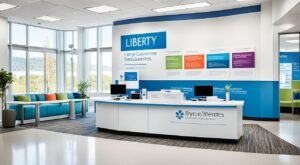The natural environment encompasses all living and nonliving components that exist naturally on Earth, including air, water, soil, climate, weather, and ecosystems. It is a complex system where various elements, such as plants, animals, and physical features, interact and influence one another. The natural environment is essential for human survival, providing us with resources, regulating the climate, and supporting biodiversity. However, human activities, such as urbanization, industrialization, and resource exploitation, have led to environmental degradation and climate change, posing significant challenges to the harmony between humanity and nature.
This article explores the concept of the natural environment, delving into its importance, the threats it faces, and the efforts to preserve and restore the delicate balance between human activities and the ecological systems that sustain us.
Key Takeaways
- The natural environment encompasses all living and nonliving components that exist naturally on Earth.
- The natural environment is essential for human survival, providing resources, regulating the climate, and supporting biodiversity.
- Human activities, such as urbanization and industrialization, have led to environmental degradation and climate change.
- Preserving the balance between human activities and ecological systems is crucial for the harmony between humanity and nature.
- This article explores the importance of the natural environment and the efforts to restore the delicate balance.
Roots of Green Building Culture
The foundations of the green building culture can be traced back to the pioneering efforts and visionary figures who championed sustainable architectural design. From an historical perspective, the evolution of sustainable buildings has been shaped by influential movements and early experiments that laid the groundwork for modern green building practices.
Historical Perspective on Sustainable Buildings
The concept of sustainable architecture has its origins in the early 20th century, when architects and designers began to explore the integration of natural elements and resource-efficient strategies into their buildings. Figures like Frank Lloyd Wright, with his renowned “organic architecture” approach, and pioneers of the Bauhaus school championed the idea of harmonizing structures with their surrounding natural environment. These early experiments laid the foundation for the eco-friendly and climate-responsive design principles that would later become hallmarks of the green building movement.
Influential Figures and Movements
As the environmental consciousness grew in the mid-20th century, influential figures and grassroots movements further propelled the green building culture. Visionaries like Buckminster Fuller, with his innovative resource-efficient designs, and Ian McHarg, who pioneered the concept of integrating design with natural systems, inspired a new generation of architects and engineers. The emergence of the environmental movement and the energy crisis of the 1970s also catalyzed a surge of interest in sustainable building practices, leading to the development of energy-efficient and renewable energy technologies.
Early Experiments to Modern Innovations
The journey of the green building culture has been marked by a steady progression from early experiments to cutting-edge modern innovations. Pioneers such as William McDonough and Michael Braungart introduced the concept of cradle-to-cradle design, while Sim Van der Ryn and Ken Yeang spearheaded the integration of passive strategies and eco-design principles. Today, the green building movement is further propelled by advancements in renewable energy, energy efficiency, indoor air quality, material selection, and waste management, ushering in a new era of environmentally conscious and resource-efficient architecture and construction.
| Influential Figures | Contributions to the Green Building Culture |
|---|---|
| Frank Lloyd Wright | Pioneered the concept of “organic architecture” that harmonized buildings with their natural surroundings. |
| Buckminster Fuller | Developed innovative, resource-efficient designs that inspired the sustainable architecture movement. |
| Ian McHarg | Advocated for the integration of design with natural systems, laying the foundation for ecological planning and design. |
| William McDonough and Michael Braungart | Introduced the “cradle-to-cradle” design approach, promoting the circular use of materials and resources. |
| Sim Van der Ryn and Ken Yeang | Pioneered the integration of passive strategies and eco-design principles into sustainable building practices. |
Principles of Green Building
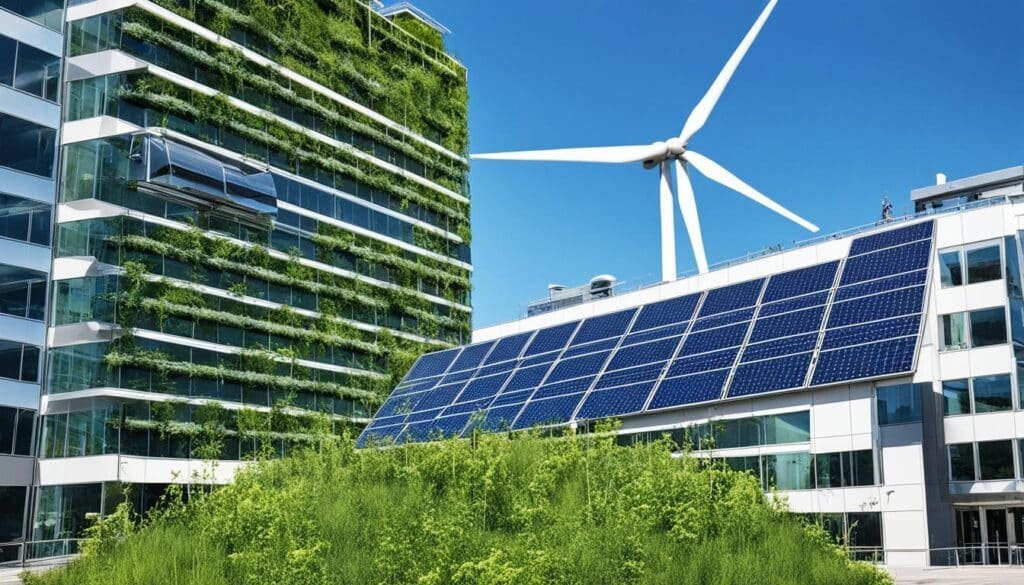
At the core of the green building culture are the fundamental principles that guide the design, construction, and operation of sustainable structures. These principles aim to minimize the environmental impact and optimize the overall performance of buildings, paving the way for a more harmonious relationship between human activities and the natural ecosystem.
Harnessing Renewable Resources
One of the key principles of green building is the utilization of renewable resources. This includes the incorporation of renewable energy sources, such as solar, wind, and geothermal power, to reduce reliance on fossil fuels and lower the carbon footprint of a building. Additionally, green building practices emphasize the use of water conservation strategies, including rainwater harvesting, greywater recycling, and efficient plumbing fixtures, to promote sustainable water management.
Meticulous Resource Management
Effective resource management is another cornerstone of green building. This involves the careful selection and utilization of sustainable building materials, prioritizing the use of renewable and recycled resources, as well as the implementation of waste reduction and recycling strategies throughout the building’s lifecycle. Green builders also strive to minimize the environmental impact of construction activities through responsible waste management and the optimization of energy efficiency measures.
Fostering Indoor Environmental Quality
In addition to the environmental considerations, green building principles also prioritize the creation of healthy and comfortable indoor environments. This includes the implementation of passive strategies, such as strategic daylighting and natural ventilation, as well as the use of active systems like high-performance HVAC and air filtration to ensure optimal indoor air quality and thermal comfort for building occupants. The selection of low-emitting materials and the incorporation of biophilic design elements further contribute to the overall occupant health and well-being.
By embracing these fundamental principles, green building practices strive to create structures that are not only environmentally responsible but also enhance the health, comfort, and productivity of the people who inhabit them. Through the integration of sustainable design, energy-efficient technologies, and a holistic approach to resource management, the green building culture continues to redefine the way we design, construct, and operate buildings, paving the way for a more sustainable and resilient future.
| Green Building Principle | Key Strategies | Benefits |
|---|---|---|
| Harnessing Renewable Resources |
|
|
| Meticulous Resource Management |
|
|
| Fostering Indoor Environmental Quality |
|
|
Cultural Impact of Green Building
![]()
The influence of green building extends far beyond the physical structure, as it intersects with the rich cultural tapestry of communities. Sustainable architectural design has the power to weave local cultures into the very fabric of buildings, preserving and celebrating the unique traditions and identities that define a place.
Weaving Local Cultures into Sustainable Structures
By incorporating regional materials, traditional techniques, and vernacular architectural styles, green buildings can become a canvas for showcasing the cultural heritage of the surrounding community. This approach not only honors the local traditions but also fosters a greater sense of community identity and attachment to the built environment. Through the integration of cultural elements, sustainable structures become more than just functional spaces; they become living embodiments of the community’s rich history and values.
Harmonizing Modernity and Tradition
The integration of modern design and traditional architectural practices is a hallmark of the green building culture. Pioneering architects and designers have demonstrated how sustainable architecture can strike a harmonious balance between the cutting-edge and the time-honored, creating iconic buildings that blend the innovative and the ancestral. This approach not only preserves the cultural heritage but also showcases the adaptability of traditional techniques in the face of contemporary challenges.
Case Studies: Iconic Green Buildings
Across the United States, there are numerous iconic green buildings that have become symbols of their local communities, embodying the intersection of sustainable design and cultural identity. From the biophilic-inspired Durst Organization headquarters in New York City to the adaptive reuse of the historic Sarjapur House in Bangalore, these case studies demonstrate how green building can enhance the sense of place and foster community engagement through the integration of local culture and tradition.
Social Aspect of Green Building
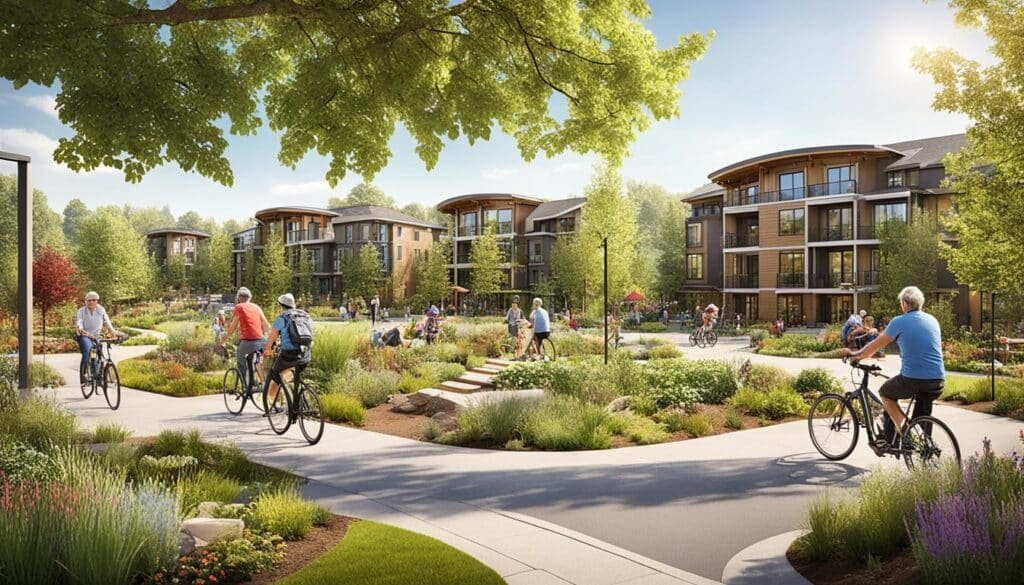
The social impact of green building extends far beyond the physical structure, as it plays a pivotal role in shaping the fabric of communities and fostering social equity. This section delves into the social aspect of green building, exploring the principles of community-centric design and the creation of collaborative spaces that enhance social integration and well-being.
Community-Centric Design
At the heart of green building lies a commitment to creating structures that seamlessly integrate with the local community. By embracing the principles of inclusive design, architects and developers are designing public spaces, shared amenities, and infrastructure that cater to the diverse needs of all community members. This community-centric approach ensures that green buildings become hubs of social interaction, fostering a sense of belonging and empowering residents to actively participate in the shaping of their shared environment.
Social Equity and Collaborative Spaces
Green building practices go beyond the physical realm, addressing the critical issue of social equity. Through the strategic placement of affordable housing options, the incorporation of universal accessibility features, and the development of collaborative spaces, green buildings are becoming catalysts for social integration and community development. These inclusive design elements not only promote occupant well-being and health but also contribute to environmental justice by ensuring that the benefits of sustainable living are accessible to all, regardless of socioeconomic status or physical ability.
| Aspect | Description | Benefits |
|---|---|---|
| Community-Centric Design | Designing public spaces, shared amenities, and infrastructure that cater to the diverse needs of all community members. | Fosters a sense of belonging, empowers residents to participate in shaping their shared environment, and creates hubs of social interaction. |
| Social Equity and Collaborative Spaces | Incorporating affordable housing options, universal accessibility features, and collaborative spaces that promote social integration and community development. | Ensures the benefits of sustainable living are accessible to all, regardless of socioeconomic status or physical ability, and contributes to environmental justice. |
Innovation and Technology in Green Construction
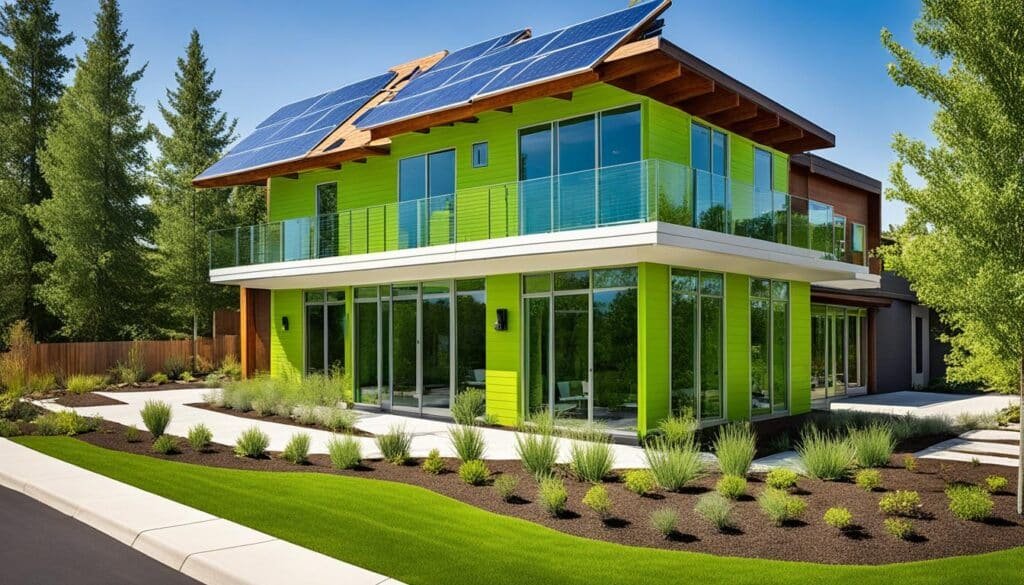
The green construction landscape is undergoing a revolutionary transformation, driven by the rapid advancements in innovative technologies and sustainable solutions. From artificial intelligence and building automation to renewable energy integration and 3D printing, the industry is embracing cutting-edge tools and techniques to push the boundaries of energy efficiency, resource conservation, and waste management.
One of the key areas of innovation in green construction is the development of smart buildings that leverage the power of the Internet of Things (IoT) and digital tools. These intelligent structures are designed to optimize their energy consumption, enhance occupant comfort, and reduce their environmental impact through seamless integration of sensors, automation systems, and data analytics.
Advancements in prefabrication and modular design are also revolutionizing the construction industry, enabling the creation of high-performance, sustainable technologies that can be rapidly deployed and adapted to various site conditions. 3D printing technology, in particular, is opening up new frontiers in the design and construction of green construction materials, allowing for the creation of complex, customized building components with minimal waste and enhanced energy efficiency.
Furthermore, the integration of building information modeling (BIM) and energy modeling tools is empowering architects, engineers, and construction professionals to make data-driven decisions, optimize building performance, and minimize the environmental impact of their projects. These digital tools enable the seamless collaboration and coordination required to achieve green building certifications and implement sustainable construction methods.
As the industry continues to embrace these innovative technologies, we can expect to see a future where renewable energy, energy storage, water recycling, and waste-to-energy solutions become the norm, driving the transition towards a more sustainable and resilient built environment.
| Innovative Technologies | Benefits in Green Construction |
|---|---|
| Artificial Intelligence (AI) | Optimizing building operations, predictive maintenance, energy management |
| Building Automation Systems | Integrated control and monitoring of HVAC, lighting, security, and other building systems |
| Renewable Energy Integration | Increased on-site energy generation from solar, wind, geothermal, and other renewable sources |
| 3D Printing | Customized, high-performance building components with reduced material waste |
| Building Information Modeling (BIM) | Collaborative design, construction, and facility management for optimized building performance |
Educating Future Generations

Recognizing the pivotal role of education in shaping the future of the green building culture, this section explores the integration of sustainable principles into architectural education and the cultivation of an eco-conscious mindset among the next generation of designers and builders.
Integrating Green Building Principles into Architectural Education
Leading universities and design schools have embraced the sustainability curriculum, ensuring that environmental awareness and green building principles are at the core of their architectural programs. Through hands-on learning experiences and an interdisciplinary approach, students are exposed to the latest green building certification standards, renewable energy technologies, and resource-efficient construction methods. This holistic education empowers the future generation of architects to become champions of sustainable design thinking and advocates for environmental ethics in the built environment.
Fostering an Eco-Conscious Mindset
Beyond the technical aspects of sustainable design, architectural education also plays a crucial role in cultivating an eco-conscious mindset among students. Through coursework, community engagement, and hands-on problem-solving activities, learners develop a deep understanding of the environmental impact of buildings, the importance of resource efficiency, and the need for renewable energy solutions. This holistic approach encourages the next generation of designers to consider the life-cycle analysis of buildings and their carbon footprint, ultimately shaping a generation of green building advocates committed to sustainable development and environmental stewardship.
Economic Benefits of Green Building
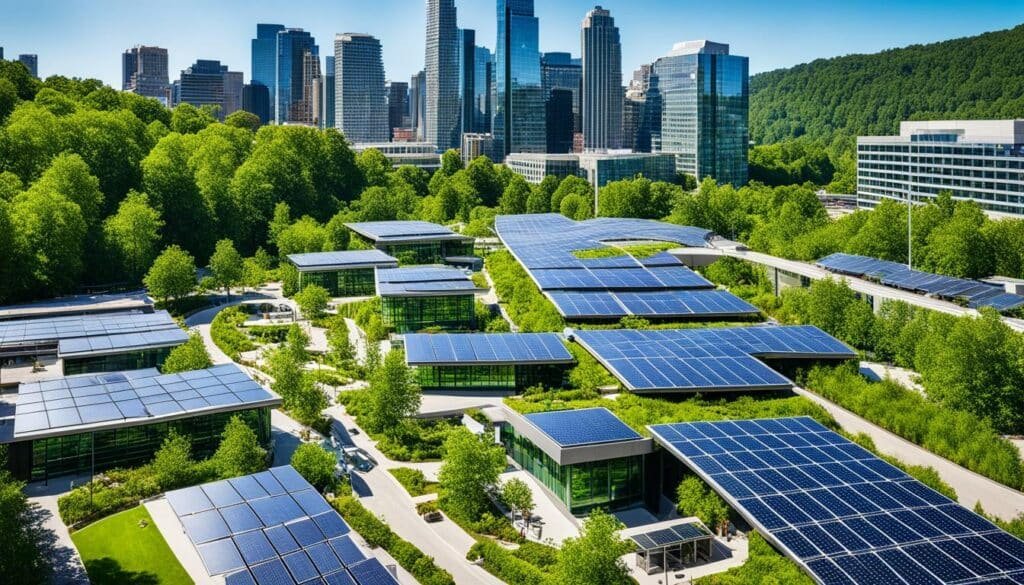
While the environmental benefits of green building are widely recognized, the compelling economic advantages make sustainable construction a viable and attractive choice for businesses, homeowners, and policymakers. From energy savings and property value increases to reduced operating costs and attractive tax incentives, the economic case for green building is compelling.
Return on Investment
Sustainable design and construction strategies can yield significant long-term savings through enhanced energy efficiency, water conservation, and lower operating expenses. Studies have shown that green buildings can provide a return on investment (ROI) of up to 20% or more, making them a sound financial decision in addition to their environmental benefits.
The increased property value of green-certified homes and commercial buildings is another key economic driver. Homebuyers and tenants are willing to pay a premium for the energy savings, improved indoor air quality, and overall sustainability features of green buildings, leading to higher resale values and rental rates.
Economic Incentives and Green Job Creation
Governments and financial institutions have introduced a range of economic incentives to encourage the adoption of green building practices. These include tax credits, green mortgages, and green bonds, which provide financial support and lower the upfront costs associated with sustainable construction.
The growth of the green building industry has also resulted in the creation of numerous green jobs, from sustainable architecture and construction to renewable energy installations and waste management. This has contributed to economic growth and the development of a more sustainable construction industry.
Challenges and Solutions

While the green building culture has gained significant momentum, it still faces a range of challenges that need to be addressed to achieve widespread adoption. One of the primary barriers is the initial costs associated with sustainable construction, as well as the resistance to change in the industry.
Initial Costs and Resistance to Change
The upfront investment required for green building projects can be a significant deterrent for some developers and homeowners. There is a common perception that eco-friendly structures are more expensive to build, which can hinder their widespread adoption. However, a cost-benefit analysis often reveals that the long-term savings on energy, water, and maintenance costs can outweigh the initial expenditure, leading to a favorable return on investment.
Additionally, the resistance to change in the construction industry can slow the transition towards more sustainable design thinking. Established practices and mindsets can be difficult to shift, and there may be a lack of education and awareness about the benefits of green building among key stakeholders, including developers, contractors, and even end-users.
Overcoming Barriers to Widespread Adoption
To address these challenges, a multi-pronged approach is required. Policy and regulation can play a crucial role in driving the adoption of green building practices, such as through the implementation of incentive programs, green building certifications, and life-cycle analysis requirements. Collaboration between industry players, public-private partnerships, and technological advancements in sustainable construction methods can also help to overcome the barriers to widespread adoption.
Additionally, education and awareness campaigns targeting various stakeholders, from developers to end-users, can help to shift the cultural mindset and sustainable design thinking. By highlighting the long-term savings, environmental benefits, and risk mitigation strategies, the industry can build a stronger case for the adoption of green building practices.
The Natural Environment
At the heart of the green building culture lies a deep reverence and commitment to the natural environment. This section explores the importance of preserving biodiversity and the vital role that the natural environment plays in sustaining human life and well-being.
Importance of Preserving Biodiversity
The natural environment is a complex and interconnected system, teeming with a rich tapestry of diverse species and ecosystems. Preserving this biodiversity is crucial, as it provides us with essential ecosystem services that support human life, from regulating the climate and purifying our air and water to providing us with food, raw materials, and medicinal resources. However, many endangered species and their habitats face threats from human activities, underscoring the urgent need for robust conservation efforts and environmental protection measures.
Harmonizing Humanity and Nature
Achieving a harmonious balance between human activities and the natural environment is a fundamental tenet of the green building culture. By embracing sustainable development practices and cultivating a deep environmental stewardship, we can work towards a future where human settlements and the natural world coexist in a symbiotic relationship. This involves integrating green spaces and urban ecosystems into our built environments, adopting biophilic design principles, and engaging in ecological restoration efforts to mend the damage caused by past human interference. Through community engagement and a collective commitment to environmental justice, we can create a more resilient and regenerative future that honors the intrinsic value of the natural environment.
In exploring the intricate tapestry of the natural environment, encompassing ecosystems, biodiversity, and landscapes, we uncover the delicate balance that sustains life on Earth. From the lush rainforests to the sprawling deserts, each geographical region offers unique ecosystems teeming with biodiversity and natural resources crucial for human survival. However, human activities, such as pollution and deforestation, threaten this delicate ecological harmony, leading to detrimental impacts on air and water quality, as well as exposure to ecological hazards. Recognizing the importance of mitigating these effects, organizations and individuals must prioritize ecological conservation and sustainable practices to safeguard the natural environment. Through strategic measures focusing on pollution control, water cycle management, and recreation planning, we can promote wellbeing and preserve the ecological integrity of our planet’s natural landscapes for generations to come.
Also Read: 10 Reasons Why Renewable Energy Is The Future
Conclusion
“Harmony In Green: Exploring The Natural Environment” encapsulates the profound interconnectedness and beauty inherent in our natural world. Through this exploration, we’ve delved into the intricate web of life, where every organism, from the tiniest microbe to the towering trees, plays a vital role in maintaining balance and harmony.
Our journey through verdant landscapes and biodiverse ecosystems has revealed the importance of preserving and protecting these environments. They not only provide us with essential resources for survival but also offer immeasurable spiritual and mental nourishment.
Moreover, our understanding of the natural environment extends beyond mere observation; it encompasses a deep appreciation for the intricate relationships between living organisms and their surroundings. By embracing sustainable practices and fostering stewardship, we can ensure the continuity of this harmonious coexistence for generations to come.
As stewards of the Earth, it is our responsibility to cherish and safeguard these invaluable treasures. Let “Harmony In Green” serve as a reminder of the intricate tapestry of life that surrounds us, inspiring us to protect, preserve, and cherish our natural environment for the betterment of all life on this planet.
FAQs
Q: What is the significance of exploring the natural environment in the context of Harmony In Green?
A: Exploring the natural environment in Harmony In Green allows individuals to connect with the landscape, understand the impact of human factors on the environment, and appreciate the beauty of agricultural lands.
Q: How does air pollution affect the natural environment in Harmony In Green?
A: Air pollution can have detrimental effects on species diversity, water and air quality, and the overall health of the ecosystem in Harmony In Green.
Q: What is the relationship between Harmony In Green and the geographical aspects of the environment?
A: Harmony In Green emphasizes the geographical features of the environment, such as waterways, rainfall patterns, and meteorological phenomena, to enhance the understanding of natural systems.
Q: How does interacting with the physical environment contribute to mental and physical health in Harmony In Green?
A: Interacting with the physical environment in Harmony In Green can have positive effects on mental and physical health by promoting recreation, relaxation, and a sense of connection to nature.
Q: What are some examples of natural resources and physical phenomena that are explored in Harmony In Green?
A: Harmony In Green delves into universal natural resources like water and air, as well as physical phenomena such as threshold effects and the council of living and non-living things occurring naturally.
Q: How does the built environment impact health in Harmony In Green?
A: The built environment in Harmony In Green can influence health effects by creating spaces that either support or hinder physical activity, social interaction, and overall well-being.
Q: Why is it important to understand the connection between Harmony In Green and the environment for sustainable living?
A: Understanding the connection between Harmony In Green and the environment is crucial for sustainable living as it promotes conservation of natural resources, minimizes negative impacts on the ecosystem, and fosters a sense of responsibility towards the planet.



